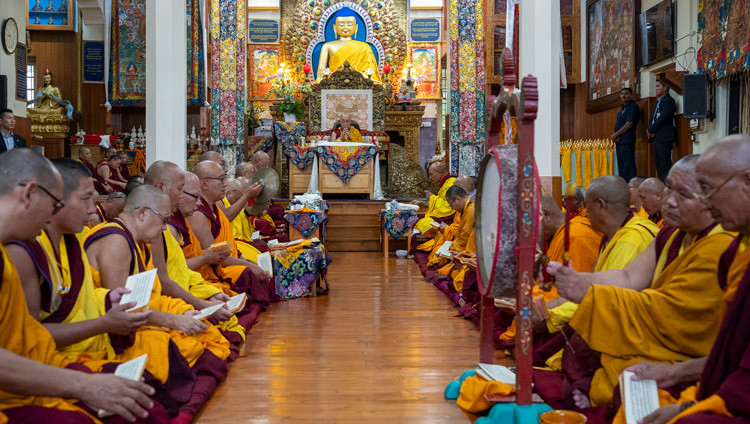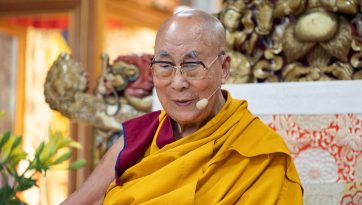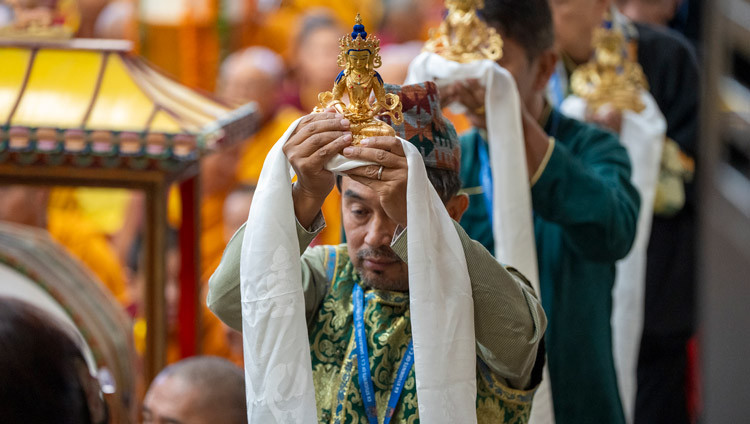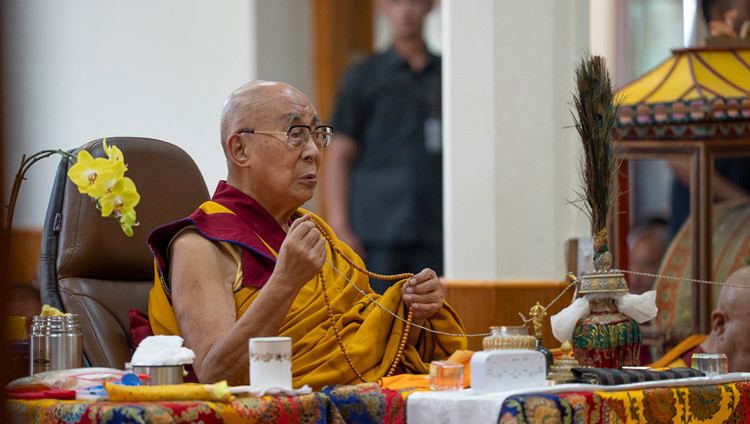PSC Releases Syllabus for CTA Recruitment Exam
DHARAMSHALA: The Public Service Commission today released the syllabus and a model question paper for the Central Tibetan Administration’s recruitment examination.
OUTLINE MODEL QUESTIONS FOR CTA STAFF ENTRANCE TEST
English Written Time: 3 hrs Total Points: 80
PART I, COMPOSITION
a)* Text of a speech to be delivered by a Kalon Tripa at a conference attended by some Heads of State, Parliamentarians, Scholars and media on CTA’s Middle Way Approach Policy to find out an amicable solution to the issue of Tibet. (2500 words)
b)* People’s Republic of China – (PRC ) claims Tibet as an “inalienable part” of PRC from 13th century onwards. Make an analytical assessment of Tibet’s political status at least 2000 years before invasion and occupation of Tibet by the PRC. (3000 words)
c)* According to PRC’s official version, the People’s Liberation Army – PLA entered Tibet to “liberate Tibetans from Serfdom & Imperialist influence.” Objectively analyze this version whether Tibetans in Tibet are truly liberated. (2000 words.)
d)* The 17th Point Agreement signed on May 23rd 1951 by the Representatives of the Tibetan Govt. & the PRC, is used by the latter as an instrument “to legitimize” its invasion & occupation. Tibetans say the Agreement was signed under duress & its provisions were violated by the PRC. Assess the claims with pros & cons of the two views in (2500 words.)
e) Unofficially, a Tibetan Guerrilla Movement was established in 1960 at Mustang, highlight important anecdotes of this movement in (3000 words.)
f)* In 1965 PRC created the so-called Tibet Autonomous Region – TAR and annexed Kham & Amdo to other provinces of China. How much autonomous right Tibetans enjoy under TAR? (2500 words)
g) A Chinese leader said “if we want a fresh air, windows will have to be opened but mosquitoes will also come with the fresh air that we have to tolerate.” Explain the quote &analyze the changes occurred based on this statement in PRC’s policy. (2500 words)
h)* Background of how the contact process initially began between the CTA and the PRC to resolve the issue of Tibet through dialogues & negotiations. (1500 words)
i)* After seven rounds of meeting between the Envoys of His Holiness & the Plenipotentiaries of PRC, the Envoys presented to the Memorandum on Genuine Autonomy for the Tibetan People to their PRC counterpart. Indicate the main points of the Memorandum along with objections raised by the PRC & the Note on the MGA given to PRC by the Envoys. (3000 words)
j) Under PRC’s legal system, Hong Kong and Macau enjoy the status of One Country & Two Systems. If the Tibetans under PRC can get this system, will that fulfill the aspirations of six million Tibetans? (2000 words)
k)* The United Nations adopted 3 Resolutions on the issue of Tibet, but the resolutions remained only in theory. Analyze the structure of UN with specific reference to the Veto Powers of the Permanent Members and state reasons for not being able to implement those Resolutions. (1500 words)
l) Make a comprehensive report on the achievements & drawbacks of farming in Tibetan Settlements in India, to be presented by a Kalon of Home Department at an International Donors’ Conference. (2500 words)
m)* Text of a speech to be given by the Kalon of Education Department at a seminar attended by some Vice-Chancellors of Indian universities and Presidents of foreign universities on the implementation of CTA’s Education Policy in the exile Tibetan schools. (2500 words)
n)* In an International Conference on Environment, Tibet has been referred as “The Third Pole.” Analyze this report & show its effect on Tibet’s climate change with reference to the livelihood of people in Asia particularly in China, India and other South Asian countries. (2500 word)
PART II, SUMMARY
The paper setter is requested to give a passage either from My Land & My People by His Holiness the Dalai Lama or The Political History of Tibet by Tsepon W.D. Shakabpa & candidates are required to summarized the most important points in the passage. (1500 words)
PART III, LETTER WRITING
i)* Write a formal letter to the Prime Minister of India, urging him/her to take into account the importance of historical & geo-political factor of Tibet while trying to resolve the vexed so-called “Sino-Indian border problem.”
ii)* Prepare a formal Tender Call Notice to competent companies &contractors to survey underground water in Gangkyi area and construction of 3 concrete water tanks.
iii) Write a formal circular to be sent from the High Level Scholarship Committee to the Tibetan Fullbright Scholarship holders stating that the Committee will take stern action against those who will not return to serve in the Tibetan community after completion of their studies in the US. (1300 words)
PART IV, WORDS & PHRASES
* Meaning of following words and phrases to be written in Tibetan.
(1) Altruism
(2) Universal Responsibility
(3) Secular Ethics
(4)De-facto
(5) De-jure
(6) Rationalism
(7)Secular State
(8)Theocratic State
(9)Feudalism
(10)Totalitarian State
(11)Genuine Autonomy
(12) Pseudo-Psychiatrist
(13)Separatist
(14) Mutual Benefit
(15)Amicable Solution
(16)Federal State
(17)Unitary State
(18)Socialist State
(19)Utilitarianism
(20)Egalitarianism
(21)Evolution
(22)Revolution
(23)Pluralistic State
(24)Sovereign State
(25)Suzerainty
PART V, GRAMMAR
* Please provide a passage with grammatical mistakes, incorrect use of Eight Parts of Speech, specially the use of Prepositions, Tense, Pronounces, Nouns, Definite & Indefinite Articles. Candidates are required to correct all grammatical mistakes in the passage.
PART VI, GENERAL KNOWLEDGE
NOTE: For correct answers, tick right words or phrases in the brackets in italics in the following sentences or write a sentence or two wherever necessary. All 25 questions are important.
1) The People’s Liberation Army – PLA defeated KMT Army in (1929,1939,1949) and established (Republic of China/Democratic Republic of China/People’s Republic of China).
2) Tibet has been regarded as a “Part of China” by the (KMT, PRC, MTAC) or by (all the three).
3) People’s Liberation Army entered into Kham & Amdo areas of Tibet in (1929, 1949, 1939).
4) The Head of the Tibetan Govt. delegate to sign the 17-Point Agreement was (Khemed SonamWangdu/Thubten Legmon/Sampo Tenzin Dhondub/Ngapo Ngawang Jigme/None of them)
5) The Agreement was signed with the (full consent of both parties/under the duress of one party/with consent of both the Governments.)
6) There are (36/46/56) National Minorities in the People’s Republic of China & PRC (officially regards/does not regard) Tibetans as one of its minorities.
7) According to PRC’s official version, the total population in the so-called TAR is (5,520,000/2,840,000/ 26,170,000)
8) Among the PRC leaders who visited Tibet after the Cultural Revolution, it was (Deng Xiaoping/Zhao Ziyang/Hu Yaobang) who openly apologized the Tibetans for PRC’s repressive policy in Tibet.
9) PRC stationed its first nuclear weapons in Tibet at Tsaidam Basin in Amdo, January (1961/1971/1981)
10) During Hu Jintao’s tenure as a Communist Party Secretary in Tibet, he declared Martial Law in (1998/1979/1989) to uphold PRC’s repressive policy in Tibet.
11) Fight against the “Dalai Clique is a live and death,” said by (Hu Jintao/Chen Quanguo/Zhang Qingli)
12) PRC’s official version of Tibet means (whole of Tibet/only TAR/short of Kham & Amdo).
13) In October (1971/1981/9191) US President George Bush signed into law a Congressional resolution declaring Tibet as an (autonomous region/autonomous prefecture/occupied country).
14) In order to help the Tibetan diasporas, the American Govt. created (Fullbright Scholarship/Congressional Gold Medal/Special Coordinator for Tibet) in October (1979/1997/2002)
15) When His Holiness & the entourages learned that PRC has dissolved the Tibetan Govt. in Lhasa, they immediately set up a temporary Tibetan Govt. in (Lhokha/Tsona/Lhuntse) on (March 18, 1959/March 20,’59/March 29,’59)
16) Coinciding with His Holiness the Dalai Lama’s birthday commemoration, the EU Parliament adopted a resolution in July (2000/2001/2002) to recognized Tibetan Govt. in Exile if PRC do not respond positively within (two/three/four) years to resolve the Tibet issue amicably.
17) The introduction of railway line in Tibet July 2006, had (great benefit for Tibetans/became more convenient for PRC) to take away Tibet’s natural resources & bring more Han migrants to Tibet.
18) His Holiness the Dalai Lama first repudiated the 17-Point Agreement in May (1956/1958/1959) in (Lhasa/Tezpur/Mussoorie).
19) His Holiness’ comment ‘my trust in the Chinese Govt. has become thinner, thinner & thinner,’ has been made in the context of (PRC’s repressive policy in Tibet/degrading environmental condition in Tibet/none responsive to the Memorandum on Genuine Autonomy).
20) The American President Franklin D. Roosevelt sent Captain Ilia Tolstoy & Lieutenant Brooke Dolan to Tibet in (1932/1953/1942) to discover (Tibet’s infrastructure/the strength of Tibetan army/routes for supplies to Chin) through Tibet.
21) Led by Tsepon W.D. Shakabpa, the Tibetan Govt. sent a Trade Delegation on (Oct. 25, 1957/Sept. 29, 1949/Oct. 25, 1947) to four countries (Japan/India/UK/USA/China/Mongolia) with (Chinese passport/Identity Certificates/ Tibetan Govt. Passports).
22) During the Tibetan People’s National Uprising in 1959 (67,000/77,000/87,000) Tibetans were mercilessly killed by the PLA in (whole of Tibet/Kham & Amdo/Lhasa alone.)
23) As an independent country, Tibetan Govt. introduced its first paper currency in (1790/1695/1890) in the denomination of (five/six/seven) paper notes.
24) In 1959 the PLA conquered Tibet very easily because (Tibet had no Alliance//Tibet had small standing army/Tibet had no UN seat/all 3 reasons.)
25) Total area of Tibet Cholkha-sum is (3.2 million square km/4.2 million square km/2.5 million sq. km.)
PART VII, TRANSLATION
A passage of medium length English Text should be given by the paper setter to judge candidates’ capability in translation from English into Tibetan. The passage can be from one of the books by His Holiness or from the Kashag’s speech on the commemoration of 52nd Tibetan National Uprising Day.
RESOURCE BOOKS FOR CANDIDATES
1. My Land & My People, English version, by His Holiness the Dalai Lama 3rd edition 1985 Potala Corporation New York
2. Freedom in Exile, by His Holiness, Harper Collins Publishers New York 10022
3. TIBET: A Political History, in English by Tsepon W.D. Shakabpa, Potala Publication 4th edition NY
4) Tibet & Its History, by Hugh E. Richardson, 2nd Edition 1994 Shambhala Publication Inc. Boston, Massachusetts – 02116
5. The Status of Tibet: Rights, History & Prospect in International Law by Michael van Praag, Westview Press 1987, Boulder Colorado – 80301
6. TIBET: Human Rights & the Rule of Law, International Commission of Jurists, 2nd Edition 1998 ICJ P.O. Box 216 CH-1219 Geneva Switzerland
7. TIBET: The Position in International Law, Report by International Lawyers, Hansjorg Mayer and Serinda Publications London SW15 6NH
8. Basic Education Policy for Tibetans in Exile, Published by the Department of Education, 2005 the booklet is a bilingual, Tibetan and English.
9. TIBET: A Source Book, All Party Indian Parliamentary Forum for Tibet, 1994
10. Report on Tibet Negotiations, March 2009-February 2010 This is the latest US Govt. policy on Tibet for details check earlier back issues in www.tibet.net
11.The Mongols and Tibet: A Historical Assessment of Relations between the Mongol Empire and Tibet, DIIR Publications Second Edition 2009
12. Tibet and Manchu: An Assessment of Tibet-Manchu Relations in Five Phases of Historical Development, DIIR Publications Second Edition 2008
PERIODICALS IN ENGLISH & TIBETAN
a) Tibetan Review, current and back issues at least for the past 3 years
b) Tibetan Bulletin, latest and back issues of past 5 years
c) Sheja, latest and back issues for last 3 years
d) Tibetan Freedom, current and back issues of past 3 years
LINK TO WEBSITES
NOTE: This is only an Outline Syllabus of the entrance test for those candidates willing to join the CTA civil service. Based on the outline syllabus, question paper setters can go deeper into the topic. The statements or questions with asterisks (*) are more important. Interview in English will be 20 Points. To get better score in the CTA staff entrance test, candidates are advised Not to Limit their knowledge within the scope of above mentioned books, periodicals and websites links only, though it is important to go thoroughly through all of the above. They should visit the Library of Tibetan Works & Archives where more relevant information for all of the topics dealt with are available. If the candidates do not have personal copies of above books, they can photocopy relevant parts from the books at the Library through formal procedures. Current and back issues of the said periodicals can also be requested at the Library or at the Department of Information & International Relations-DIIR.
To get refreshed in English grammatical structure, it is important to go through a reliable grammar book with focus on what has been asked above. Candidates with Bachelor of Commerce (B.com) Degree must be well acquainted as how a formal Tender Notice is issued, those who need to know more, can go through the relevant sections major English daily papers. Google website will provide abundant information on China and its policy on Tibet. For more relevant information, it is important to go through the above official links of the People’s Republic of China.




